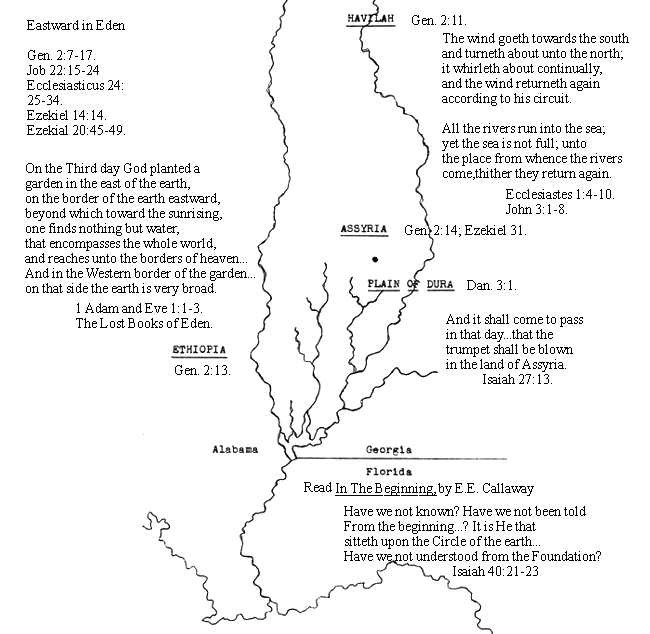
THE GARDEN OF EDEN IN GEORGIA
Son of man, set thy face toward the South, and drop thy word toward the South, and prophesy against the Forest of the South field;
And say to the Forest of the South, Hear the word of the Lord; Thus saith the Lord God; Behold, I will kindle a fire in thee, and it shall devour every green tree in thee, and every dry tree: the flaming flame shall not be quenched, and all faces from the South to the North shall be burned therein.
And all flesh shall see that I the Lord have kindled it: it shall not be quenched.
Then said I, Ah Lord God! they say of me, Doth he not speak parables...(Ezekiel 20:46-49).

Out of Eden
And the Lord God planted a garden eastward in Eden; and there he put the Man whom He had formed (understand Genesis 5:1,2; Eph.4:13,14)...
And a river went out of Eden to water the garden, and from thence it was parted, and became into Four heads...(Genesis 2:8-10).
__________
"Now the garden was watered by One river which ran round about the whole earth, and it was parted into Four parts. And Phison, which denotes a multitude, running into India, makes its exit into the sea, and is by the Greeks called Ganges. (Thus the teachings of Adam/Manu found there way into the entire structure of Vedic philosophy).
Euphrates also, as well as Tigris, goes down into the Red Sea (which, according to this purely apocryphal, but factual account of the four rivers, eventually becomes the Pacific Ocean, as well as all the other oceans of the world. For the Red Sea is where the great Red Serpent lives, and this creature comprises all the peoples and nations that inhabit the body of the great Continent, Leviathan). Now the name Euphrates, or Prath, denotes either a dispersion, or a Flower; By Tigris, or Diglath, is signified what is swift with narrowness (as these mysteries being swept through the narrow place at the center of the Oracle, from West to East in those ancient times)…
And Geon runs through Egypt, and denotes what arises from the East, which the Greeks call Nile." Josephus's Antiquities I.I.3.
__________
The words of the Preacher, the son of David, king in Jerusalem.
Vanity of vanities, saith the Preacher, vanity of vanities; all is vanity.
What profit hath a man of all his labour which he hath taken under the Sun?
One generation passeth away, and another generation cometh: but the earth abideth forever.
The Sun also ariseth, and the Sun goeth down, and hasteth to the place where he arose.
The wind goeth toward the South, and turneth about unto the North; it whirleth about continually, and the wind returneth again according to his circuits.
All the rivers run into the sea; yet the sea is not full; UNTO THE PLACE FROM WHENCE THE RIVERS COME, THITHER THEY RETURN AGAIN...(Ecclesiastes 1:1-7).
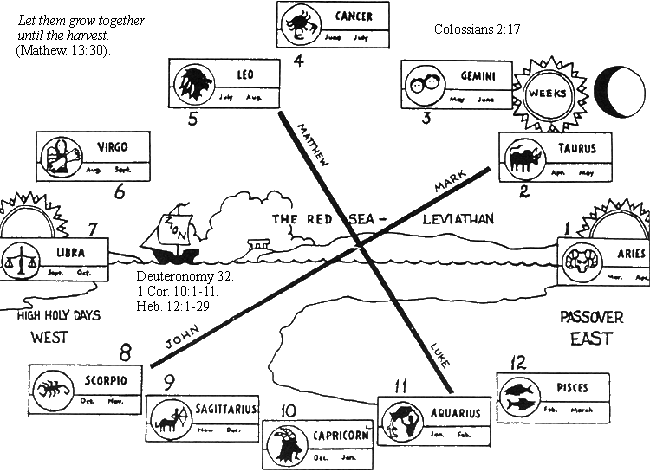
Haven't we known from the beginning...Isaiah 40:21-24 (KJV)
SACRED RIVERS
by W.T.S. Thackara
Explore the River of the Soul, whence or in what order you have come: so that although you have become a servant to the body, you may again rise to the order from which you descended, joining works to sacred reason (logos). The Chaldean Oracle, 172.
Rivers appear frequently in the world's sacred traditions as symbols of divine influence and of life's interdependence. They evoke an image of spiritual-intellectual energies cascading through the manifold planes of cosmic and individual life--linking us intimately with our spiritual source, nourishing and sustaining us, and flowing forth to connect us with all things. We may recall, for example, the Hindus' description of the Ganges descending from heaven, encircling Brahma's city of gold on the summit of Meru, the earth's central mountain, then dividing into Four rivers which flow to the four points of the compass. Embodied in this imagery--geometrically describing a Pyramid--is a set of ideas suggesting a continuous flow of life, wisdom, and guidance from our original homeland to every corner of the world.
Like the ancient Egyptians who understood the gift of the Celestial Nile as well as of its earthly counterpart, we can be enriched by exploring these ancient waterways; so that next time we see a Christian baptism, or millions of Hindus assembling on the banks of the Ganges, the inner significance of these rites and celebrations will be apparent, serving as a refreshing draft from the Well of Memory deep within us. For sacred rivers are not only mythic reminders of forgotten truth, they represent the ever-present stream of who and what we essentially are: not a static being, but a dynamic ever-becoming flow of godlike radiance.
Turning to the source of rivers at the beginning of time, ancient philosophers often described a seed or egg containing the potency of our universe gestating in the womb of infinite space and duration...
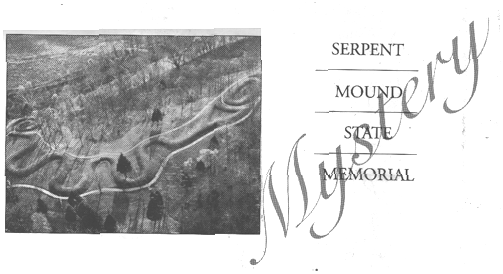
Adam's County, Ohio.
...Following the analogy of nature, which is cyclical and self-reproducing throughout, this seed may be seen as the fruit of our ancestors, previous universes infilled with life, intelligence and consciousness. It is natural then to visualize this infinitesimal seed bursting forth at its appointed time in a torrential river of consciousness-energy substance, flooding space with radiant "waters"--the primordial chaos--from which arises galaxies, star systems, and garden planets like our own Mother Earth. On the microcosmic scale, even our physical bodies--whose atoms were spun in the heart of the sun--are an ever-flowing fabric of dazzling, coruscating energies, coursing on streambeds patterned in the collective mind of our creators.
These thought may be discerned in our oldest myth--for what did the ancient Sumerian and Babylonian poets have in mind when recounting the adventures of Gilgamesh: whose search for immortality and the meaning of life led him to humanity's Forefather, WHO DWELT "ACROSS THE SEA" with the gods IN THE "GARDEN OF THE SUN" at the "MOUTH OF RIVERS"? Perhaps they, too, had a natural intuition of the periodically surging life-force flowing from the sun and beyond into our world. It is a theme mirrored in the story of another well-known garden, this one here on earth."There was a river flowing from Eden to water the garden, and when it left the garden it branched into Four streams...
As rivers descend from their pristine sources, from rain and snow, they pick up the silts and other qualities of the regions they pass through, as well as the grosser pollutions we humans contribute to muddy these life-giving streams, whether they be physical of mental. Homer and Plato almost certainly had this latter aspect in mind when describing the descent of rivers into the nether worlds. In the Greek cosmogony, the Titan Oceanus, first-born of Heaven and Earth, is described as the father of all rivers and is himself a celestial river whose waters surround the earth. Among his daughters, sometimes numbered in the thousands, are the Four principle rivers of the underworld, and also Lethe, the River of Forgetfulness and Oblivion. These eventually combine to flow South...until they discharge their remaining contents into Tartarus. Here in the underworld they function as a purgative, cleansing human souls of selfish mental and emotional qualities which are "lethal" or otherwise harmful to their evolutionary progress (Cf. Phaedo 14).
THE SUBJECTIVE REALM OF THE EAST
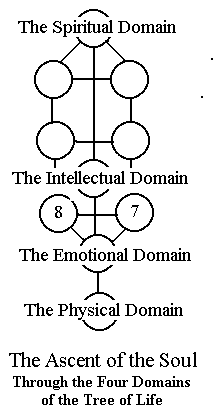
THE OBJECTIVE REALM OF THE WEST
Myths suggest that the sacred river is an integral feature of the spiritual-mental-physical ecosystem of the universe, and its descent through the three worlds of heaven, earth and the underworld is perhaps given fullest expression in the mythology of the Ganges, of Ganga, the holiest of India's rivers. Personified as a goddess, Mother Ganges is the life-giving maternal waters, the intelligent Feminine energy of the universe, and wife/consort of the great god Siva, the destroyer of form, regenerator of life, and patron of mystic students...thus enabling them to attain paradise.
Ganga's descent to earth in Three torrents and her division at Meru's summit into Four rivers correlates with the myth of the Seven Ganges, which Hindus today identify with the Seven rivers IN INDIA (get the connection)? These may also be interpreted as representing the Seven planes of the universe: Seven grades or qualities of conciousness-substance originating from a single supercelestial source, flowing through and thus comprising the totality of our cosmos. Or again, on the human level, they suggest the three aspects of consciousness--spirit, intuition, and intellect--and the Four energy-substance principles composing our physical vehicles. Sunrise, Theosophical Perspectives, Oct/Nov 1994.
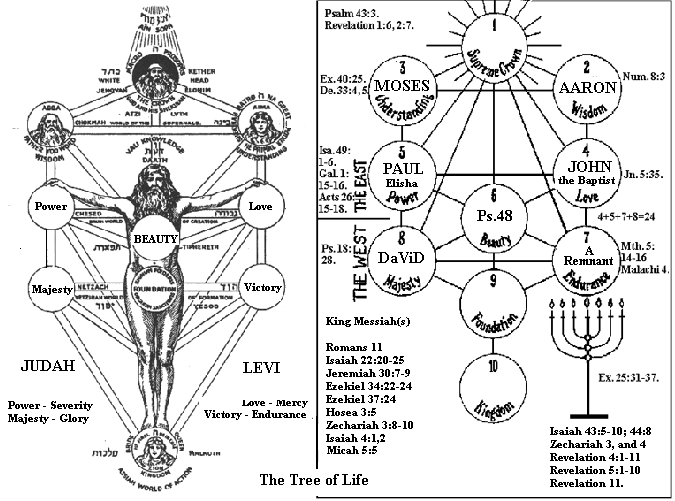
THE LOTUS FEET OF VISHNU
ENOCH'S (PAUL'S) ASCENT TO THE THIRD HEAVEN
(2 Corinthians 12:1-9 KJV)
And in the midst of the trees THAT OF LIFE, in that place where the Lord rests when He goeth up into PARADISE; and this Tree is of ineffable goodness and fragrance, and adorned more than any existing thing; and on all sides it is in form gold-like and vermillion and fire-like, and covers all, and it has produce from fruits. (Galatians 5).
Its roots are in the Garden at the earth's end. And PARADISE is between corruptibility and incorruptibility. (see 1 Corinthians 15:54-58).
And Two springs come out which send forth honey and milk, and their two springs send forth oil and wine, and they separate into Four parts, and go round with quiet course, and go down into Paradise of Eden between corruptibility and incorruptibility... Secrets of Enoch 8:3-6.
APALACHICOLA NATIONAL FOREST
T he Apalachicola National Forest consists of a half-million acres of land, of which one-half is located in Liberty County. This forest is a land of swamps and hammocks untouched by man, as primitive still as when the Indians for whom it is named trod its many trails and canoed in its many waters. For recreational purposes ten areas have been developed. The most extensive being Camel Lake, a few miles south of the city of Bristol. At the lake there is swimming, boating and skiing and throughout the forest are many acres for fishing and hunting for such game as deer, bear and the American gobbler. Here, too, is the Florida panther, the only state in the eastern United States where the panther is found, although hunting it is forbidden. Many dirt roads be-sect the great forest making access quite easy for the visitor.
THE APALACHICOLA RIVER
T he great river of Apalachicola, (from the Indian tribal name Apalachee), flows southward from Georgia to the Gulf of Mexico and it's waters wash the entire western border of Liberty County. It has been a fishing paradise for the Indians of old and also for modern man, and it has been a transportation route to carry agricultural goods, industrial products and military goods during the Civil War. The central crossing of the river has always been at Bristol, accomplished first by hand ferry, then powered ferry and then by a bridge span. Construction of a new bridge and renovation of the old bridge has been completed to accommodate the heavy traffic flow of State Route 20.
THE GARDEN OF EDEN
The biblical Garden of Eden has been lost in the wilderness of time but there is a claim of discovery and it exists in Liberty County. Here, it is claimed, along the shores of the Apalachicola River, in a stretch of scrub-filled land, is the site of the true Garden of Eden. Some say that this assertion is fiction, without foundation, while others say that it is true and a book has been written to support the claim. There is scientific evidence that the adjacent river bluffs and ravines are the same today as they were a million years ago but evidence of a garden environment has not been affirmed. But if the claim is true, then here in the pleasant clime of Liberty County, Florida...and here was the home of Adam and Eve.
Both the foregoing, and the following article, were taken from
the internet:
Published on Sunday, May 11, 1997
It's a Tuesday, sometime between the beginning and the end of the world, and Harry Hagan is driving his van to the Garden of Eden.
This van has some problems. Its heater fan continues to run when the ignition is turned off, for example, and a weird kind of engin rattle is audible during acceleration.But in the context of this trip, so what? Hagan's van could have two dead cylinders and a dime-sized radiator-hole, and still it wouldn't matter. The Garden of Eden, you see, is only a 17-minute drive (including delays caused by road construction) from Hagan's home in Blountstown, a small Panhandle town (pop. 2,500) that hugs the west bank of the Apalachicola River.
Hagan, who refused to give his age but looks about 55, is now halfway across the bridge to Bristol (pop. 1,000), which hugs the river's east bank. He motors through Bristol, then turns north onto State 12. Just outside the town limits, he proclaims: "There it is!" Visible out the driver's side window is a huge fist of woods, which is bisected by a rutted dirt path. A tiny hand-lettered sign identifies this path as: "GARDEN OF EDEN ROAD."
Hagan steers his van about a hundred yards down Garden of Eden Road, then stops - a metal gate blocks the road; a small cut in the abutting barbed-wire fence allows only humans to pass. "Are you ready?" asks Hagan, who is outspoken and sarcastic and kind of a Burl Ives lookalike. He disembarks from the van and squints into the late-morning sun. "Are you ready to enter the`Garden of Eden?"
It sounds bizarre and kind of crackpot-ish, like saying that the Holy Grail has just been unearthed outside Nashville. But a lot of people in Bristol and Blountstown actually seem to believe that the original Garden of Eden is located in their backyard. "I definitely do believe that," says Hagan, owner/operator of the only two radio stations in Blountstown. "I haven't been convinced that it's not the case," says Johnny Eubanks, publisher of the only newspaper in Bristol. "Beyond reasonable doubt?" asks Liberty County Judge Ken Hosford, 40. "I don't think that the evidence is that strong. But if you're looking at it more like from a civil standard - the preponderance of the evidence, you know, a 50-50 type of thing -it's a lot more compelling."
The theory has kind of been floating around since the 1960s, when an eccentric Alabama-born lawyer named E.E. Callaway published a book called In the Beginning. According to Callaway: In 1946, God lured him from Lakeland, in southern Florida, to Bristol for unknown reasons. Soon after he arrived in Bristol, however, the purpose of his move revealed itself--he was to show the world the location of the Garden of Eden. He started gathering information. After 20 years, he put all of it into a 99-page book. This book points to all kinds of Biblical "evidence" (more on this later), and arrives early on at a fantastic conclusion: "I have definitely located and pointed out the Original Garden of Eden,"
Callaway asserts on page 14. Although not a bestseller, the book brought Callaway international attention - a team of Israeli rabbis once visited him at his tree-shaded Bristol home to ask him some questions. By most accounts, Callaway was more than willing to entertain such groups. Indeed, he apparently had some trouble not talking about the Garden of Eden.
"When I first got to town in 1972, Callaway dropped by to welcome me," says Blountstown lawyer Bill Corbin, 55. "He spent 25 minutes talking about the Garden of Eden, and he only stayed for half an hour. I had never heard this stuff before, you know. I didn't know what was going on." Callaway's not talking anymore, however. He now lies in a simple cemetery on the edge of Bristol. His small granite headstone is surrounded by dead leaves and dead grass. On some mornings, though, it catches the light and sort of shines.
Hagan is not alone as he walks into the Garden of Eden. By his side is a 47-year-old former drug addict with the peculiar name of Ivey Bailey. Bailey is kind of integral to this story. A tireless and immensely agreeable guy, Bailey claims to have had some visions himself recently about the Garden of Eden (and about his youth organization, among other things), and he says he has more or less picked up the torch E.E. Callaway dropped when he died, at 92, in 1981.
Bailey, in other words, takes this whole Garden of Eden thing pretty seriously. Hagan doesn't. They're kind of like an Odd Couple of Garden-of-Eden believers. This is important, in a way. It's also frequently hilarious. Before they got to the Garden, Hagan and Bailey stopped in at the local headquarters of the Nature Conservancy, where they learned that the organization had purchased the 1,300-acre Garden of Eden in 1982, with $1 million from an anonymous donor. (The Nature Conservancy, incidentally, is a private organization that buys land all over the country in the interest of preserving it. According to its literature, it has "protected" more than 600,000 acres in Florida alone. Its agents routinely call the Garden of Eden tract just that - "the Garden of Eden tract" - though they insist the Conservancy bought it because of certain peculiar formations there--namely, several steep ravines - and not because of any alleged Biblical significance.)
On the drive out of Conservancy headquarters, Bailey leaned over the backseat and said, "Wooooooh, is that spooky or what? A million dollars donated by an anonymous donor? I'm tellin' you guys, you're being woven into the fabric of a miracle." Hagan laughed sarcastically. "What's the miracle, Ivey? That we got a reporter to come out and cover this? Bailey sighed and shook his head. This sort of thing would happen over and over. During the three-hour hike through the Garden of Eden, Hagan managed to crack all kinds of irreverent jokes in between wheezy gasps for air and repeated forehead-moppings. At 12:39 p.m., for example, he said, "I thought Adam and Eve were supposed to wanna stay in the Garden of Eden? So how come I can't wait to get out of here and back into the air-conditioning?" He laughed wildly. Faced with these cracks, Ivey would inevitably shake his head and say "Harrrryyyy" scoldingly, then endeavor to give the proceedings a more serious tenor. At 12:41, in response to Hagan's latest outburst (and after the requisite head-shake and scold), Bailey talked about his visions for awhile, and how he genuinely believes it to be his God-given purpose to get out the story of the "real" Garden of Eden.
"I am a true believer," Ivey then emphasized. "A true believer." Hagan, meanwhile, repeatedly talked about "exploiting" the Garden of Eden and "capitalizing" on it. "I believe a hundred percent that it's the true Garden of Eden," he said while slumped inside his climate-controlled radio station after the hike. He then flashed a sinister grin, laughed slyly and said: "We'll get more tourists if I say that."
It could probably be argued that many (if not most) believers have entertained, at one time or another, some crass Hagan-type thoughts. The Bristol publisher Johnny Eubanks, for one, admits that he and seven other investors purchased the Garden of Eden in the 1970s as an "investment." "We were trying to capitalize on a planned development," said Eubanks, 65. "See, there was this group of people from Chicargo"--that's the way he says it, Chicargo - "who were going to build a Biblical theme park there, and one of 'em, strangely enough, was a Jewish fella. Anyway, it was going to have the same type of activities that your Six Flags would have or your Disney World, you know, but it was going to have a Garden of Eden-type theme." He paused for awhile, then picked back up: "Had that gone through, we woulda made a lot more money than we did." Even "true believer" Bailey instructed you to "write the story up good," reasoning this might give him a better chance at landing on a television talk show sometime soon.
Of course, not everybody around Blountstown and Bristol is a believer. The local religious community seems to have long ago dismissed Callaway's theories. Christian dogma, after all, has always put the site of the Garden of Eden somewhere around the Middle East. John Banks, however, seems to have given a little more thought to his disbelief. A retired safety engineer living in Blountstown, he now amuses himself by writing books on "human behavior," and playing in a band, and some other stuff that was over your head. He kept calling Panama City "Pan City" and volunteered to do some "field work" for you. He declined to reveal his age. "Just put in there that I'm retired," he said, "and they'll know that I'm up in years."
Concerning Callaway's book, he thinks it makes for a "wonderful" folk tale. "But I just doesn't feel there's that much sense in it," said Banks. "There's no doubt about it - it's entirely illegitimate. There is no foundation for the theories, I'm sure of it. From an academic sort of view, all his `evidence' is worthless." Now might be a good point to examine some of Callaway's "evidence." Some of it is ridiculous.
In Genesis, the Bible states that giants, mighty men roamed the Garden during pre-Flood days. So, on page 61 of In the Beginning, Callaway offers the astonishing (and entirely false) "evidence" that the skeleton of a giant man was once unearthed around Sneads. And some of it is just plain strange. Throughout his book, Callaway claims to have interpreted much of his "evidence" using the "basic proportionals" of 1, 4 and 7; the "primary proportionals" of 13, 19, 25 and 31; and the "secondary proportionals" of 10, 16, 22 and 28. (Your guess is as good as anybody's.)
But some of Callaway's arguments seem to make sense:--The Bible says that the Garden of Eden was watered by a river with four heads; the Apalachicola River has four heads. The Bible says that one of these head-rivers flows through a place full of gold, gum resin and striated marble: Georgia is rife with all three.
- The Bible says that the Garden of Eden contained an extraordinary variety of flora and fauna; the "Garden of Eden tract," according to the Nature Conservancy's Greg Seamon, contains one of the most rare and diverse ecosystems known to man: that of the steephead ravine.
The Bible (at least the King James version) says that Noah built his Ark from "gopherwood" culled from the Garden of Eden; the "Garden of Eden tract" is one of the few places on earth where Torreya taxifolia, more commonly known as the gopherwood tree, grows. None of this is proof, of course. It could easily be argued, for example, that the Biblical gopherwood and the Liberty County gopherwood are simply namesakes. If nothing else, though, there's enough semi-plausible stuff there for believers to at least cling to.
"Here's what I think," said Ken Hosford, the Liberty County judge, as a sort of summation. "If it were proved true that the Garden of Eden was really here, you know, I think that would be nice. I'd sort of smile about it. But if it were proved not true, I wouldn't be alarmed. It wouldn't make or break my day either way." This statement kind of defies easy analysis, yet it seems somehow telling. Hosford simply could have been distancing himself from a semi-questionable theory, of course. But it's also possible that he was trying to communicate something deeper about how, past a certain point, impressiveness is corrosive to the psyche. And it's at least conceivable that he was saying that he just doesn't need the Garden of Eden to be north of Bristol, which is not at all the sense one gets from Harry Hagan and Ivey Bailey, although they have their disparate reasons.
The two men have been walking through Eden for about an hour and a half now, up and down 200-foot ravines, past live oaks and cacti, under an achingly blue sky. Suddenly, Hagan points to a pristine lakeshore and says, "See, that's where Adam and Eve built their log home out of gopherwood." He wheezes a crazy laugh. This brings the standard head-wagging and scolding ("Harrrryyyyy") from Bailey. But it also apparently wounds him in an unprecedented way. "I wish you wouldn't laugh when you say stuff like that," he says, and adds, kind of sternly, "I'm serious about this stuff." Hagan stops abruptly and turns around. His next 31 words are a weird mix of shallowness and depth, irreverence and insight. They seem to capture the situation north of Bristol as good as any 31 (or 310) words can. For these and other reasons, maybe we should let them be the last words in this article:
"Well, Ivey," says Hagan, "when I talked to God the other day, I asked Him, `Is humor OK?' And He said, `Yeah, Harry, humor's all right. I have a sense of humor Myself.'"
© 1997 The News Herald
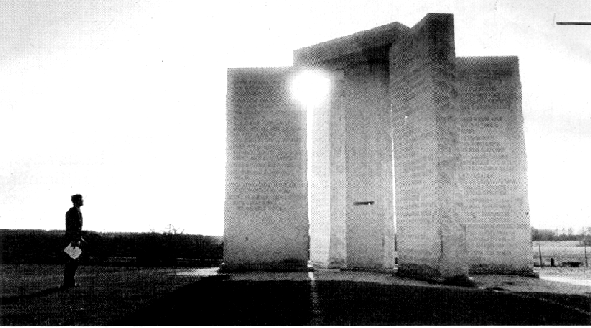
Standing nearly 20 feet tall, the Georgia Guidestones dominate the landscape near Elberton
A Mystery in Northeast Georgia
Most of State 77 looks like any other two-lane blacktop road winding through rural northeastern Georgia. Small farmhouses sit back from the highway, and cattle graze in the pastures along the roadside. But in one pasture a few miles from the Georgia-South Carolina state lines, a huge granite monument called the Georgia Guidestones turns the heads of people passing by.
Rising nearly 20 feet in the air, the guidestones could easily be mistaken for the ancient Stonehenge monument in England. The unusual structure is possibly the largest granite monument ever constructed, according to Hudson Cone of the Elberton Granite Association. It is certainly one of the most mysterious.
Five upright granite slabs, each weighing more than 40,000 pounds, support a center "gnomon" stone. Covering the slabs, written in eight languages, are the guides, 10 rules for rebuilding civilization if there ever is a need. And like the ancient Druid structure that inspired these markers, astronomical features mark the rising of the North Star and the sun, as well as the summer and winter solstices.
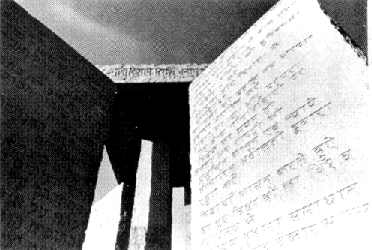
The Georgia Guidestones were quarried, carved, and set up by a granite company in nearby Elberton. But the identities of the people who designed and paid for the huge monument remain a mystery. According to Cone, the strange tale started one Friday afternoon in 1979, when a visitor met with Joe Fendley, president of the Elberton Granite Finishing Company and mayor of the town. The stranger told Fendley his plans for the giant monument and asked if the Elberton company could build the Guidestones "Fendley thought the man was kidding," Cone recalls. "He told him what something of that size would cost and the guy said 'no problem.'"
Elberton's stonecarvers went to work, carefully inscribing the 10 guides onto the huge granite slabs that had been hauled from one of the city's quarries. The guides were written in English, Russian, Hebrew, Arabic, Chinese, Hindi, Swahili and Spanish. Among other things, the rules warn future generations to "avoid petty laws and useless officials," "protect people and nations with fair laws and just courts," and "unite humanity with a living new language."
Why pick an out-of-the-way place like Elberton, Georgia, to put up a guide for the future? According to Cone, "they needed a place with a warm climate near a granite production area. So this was the best place they could find. But other residents point out that this section of northeast Georgia has always been a place of mystery. A historical marker about a half mile from the guidestones relates that the Cherokees considered the area "the center of the world," and for centuries they held religious ceremonies nearby. Only the people who designed the monument know for sure if its part of that long mystical tradition.
The Georgia Guidestones are located about 7 miles north of Elberton, Georgia, on State 77. For details, contact The Elberton Granite Association, Box 640, Elberton, Georgia, 30635.
Have ye not known? have ye not heard? hath it not been told you from the beginning? have ye not understood from the foundations of the earth?
It is He that sitteth upon the Circle of the earth, and the inhabitants thereof are as grasshoppers; that stretcheth out the heavens as a curtain, and spreadeth them out as a tent to dwell in:
That bringeth the princes to nothing; he maketh the judges of the earth as vanity.
Yea, they shall not be planted; yea, they shall not be sown: yea, their stock shall not take root in the earth: and He shall blow upon them, and they shall wither, and the whirlwind shall take them away as stubble...(Isaiah 40:21-24).
The Lower Garden of Eden
and the Tree of Life
A River Went Out of Eden...(Genesis 2:10-14).
"Now the garden was watered by One River which ran round about the whole earth, and was parted into Four parts. And Phison, which denotes a multitude, running into India, makes its exit into the sea, and is by the Greeks called GANGES.
EUPHRATES also, as well as TIGRIS, goes down into the Red Sea, (where the Great Dragon, Leviathan, lives). Now the name Euphrates, or Prath, denotes either a dispersion or a Flower, (as in the mysteries of the Far East, and eventually, as in Florida). By Tigris, or Diglath, is signified what is swift with narrowness (as these mysteries being swept from the West in ancient times, through the center of the mysteries of the Tree of Life, to the East)...
And Geon runs through Egypt, and denotes what arises from the East, which the Greeks call NILE." Josephus' Antiquities of the Jews I.I.3.
__________
And out of the ground made the Lord God to grow every Tree that is pleasant to the sight, and good for food; the TREE OF LIFE also in the midst of the garden, and the Tree of the Knowledge of Good and Evil...(Genesis 2:9).
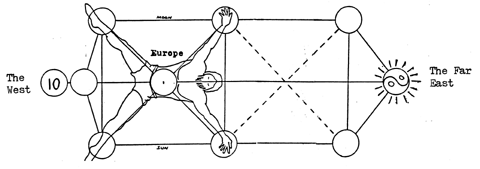
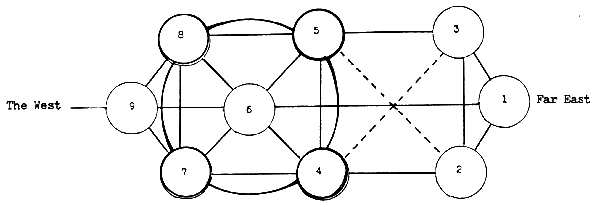
It was an evolving understanding of the spiritual, cosmological, natural and psychological, and unfolding historical dimensions of this symbol, that was carried abroad in ancient times. These ideas were carried out of Eden during the final centuries of the Atlantean age, across the dark Atlantic to Britain, across Europe (where the Great Dragon lay hidden beneath the feet of men) into the East--onto the plains of Mesopotamia. From there they found there way down into Egypt and into India, and merged with the wisdom of all the other peoples of the Earth to form the very architecture of human consciousness that has been handed down to us in our time--the universal structure of the World Tree, THE TREE OF LIFE:
There is a Fig Tree in ancient story, the Giant Aswatha, the everlasting, rooted in heaven, its branches earthward:
Each of its leaves is a song of the Vedas, and he who knows it knows all the Vedas.
Downward and upward its branches bending are fed by the Gunas (the constant interplay of the Three worlds). The buds it puts forth are the things of the senses. Roots it also has reaching downward into this world: the roots of man's actions.
What its form is, its end and beginning, its very nature, can never be known here (in India)." Bhagavad Gita XV.
__________
"The Rig Veda is a collection of more than a thousand hymns composed in northwest India about 1500 B.C., in an archaic form of Sanskrit...In addition to this canon numerous myths appear...composed a few centuries later, known as The Brahmanas. These texts were not committed to writing for many centuries, but an oral tradition preserved them and later Hindu religious literature draws heavily upon their character and events.
The central myth in the Rig Veda is the myth of creation. This is described in several different ways. Often the universe is said to have come into being out of chaos, when a God--Indra, king of the gods, and God of rain, or Vishnu, a Solar deity--separated Heaven and Earth (East and West). Then the Sun rose and from that spot, the Navel of the Earth, a Great Pillar was erected to prop apart Heaven and Earth. The Pillar is the axis of the world.
There were now Three worlds: Heaven (the East), Earth (the West), and an intervening world (the Sea in between, where the Great Dragon lived)...which Vishnu measured out in Three great strides." Mythology, edited by Richard Cavendish, pp.15,16.
__________
Varuna, King, of hallowed might, sustaineth erect the Tree's stem in the baseless region.
Its rays, whose root is high above, stream downward. Deep may they sink within us and be hidden...(Rig Veda, Book I. Hymn XXIV.7).
__________
The other Fires are, verily, thy branches; the Immortals, all rejoice in Thee O Agni. (See Leviticus 1:7; 23:8). Centre art Thou, Vaisvanara (Agni), of the people, sustaining men like a deep-founded pillar.
The Forehead of the Sky, Earth's Centre, Agni became the messenger of earth and heaven...(Rig Veda, Book I, Hymn LIX).
__________
Whither by Day depart the constellations that shine at night, set high in heaven above us? Varuna's Holy Laws remain unweakened (see Exodus 24:10-18), and through the night the Moon moves on in splendour...
Bound to Three Pillars captured Sunahsepa thus to Aditya (Varuna) made his supplications...
Loosen the bonds, O Varuna, that hold me, loosen the bonds above, between, and under. So in thy Holy Law may we made sinless belong to Aditi, O thou Aditya...(Rig Veda, Book I, Hymn XXIV.13-15).
__________
And Moses was (also) learned in All the wisdom of the Egyptians...(Acts 7:22):
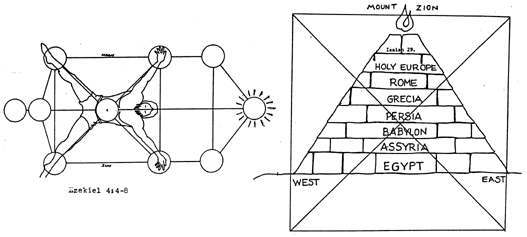
Genesis 15:1-16...KJV.
"At each end of the Tuat was a space which was neither wholly darkness nor wholly light, the Western end being partially lighted by the Setting Sun, and the Eastern end by the Rising Sun...
"From the pictures in the book Am-Tuat and the Book of Gates we learned that a river flowed through the Tuat (the Underworld), much as the Nile flowed through Egypt, and we see that there were inhabitants on each of its banks, just as there were human beings on each side of the Nile. At one place the river of the Tuat joined the Great Celestial Waters which were supposed to form the source of the earthly Nile.
How, or when, or where the belief arose it is impossible to say, but it seems that at a very early period the inhabitants of Egypt thought that the souls of the dead when they departed from this world made their way into the Tuat, and took up their abode there; and long before the Dynastic Period the Tuat was regarded throughout Egypt as the kingdom of the dead...
Of the gods the only one about whose successful passage of the Tuat there was no doubt was Ra, or according to the priests of Amen, Amen-Ra, for he arose each morning in the East (see Malachi 4:1,2), and it was manifest to all that he had overcome whatsoever dangers had threatened him in the Tuat during the past night. This being so, it became the object of every man to obtain permission to travel in the boat of Ra through the Tuat." The Egyptian Heaven and Hell, by E.A. Wallis Budge, pp.88-91.
__________
"It would be a mistake to suppose that the writers of the Scrolls...were inspired only by recollections of things past or that they chose their way of life simply because they were unsettled by political turbulence or disgusted by the venality of the Jerusalemitan priests. They were swept by other winds. One of these was the widespread and well-attested contemporary belief that the Great Cycle of the ages was about to complete its revolution. This belief was based on a conception, which can be traced to remote Indian antiquity, that existence consists not in linear progressive development--that is, in history, (which it does)--but in a constant cyclic repetition of primordial and archetypal events. When major upheavals occurred, it was promptly supposed that the cycle was nearing its end, that the Great Year was at hand, and that cosmos was about to revert to chaos. The primal elements, restrained and regulated at the beginning of the world, would again be unleashed; all things would dissolve in an overwhelming deluge (war) or be burned in that everlasting fire which rages in the depths of the earth. Then the cycle would begin again; a new world would be brought to birth." The Dead Sea Scriptures, by Theodor H. Gaster, p.8.
__________
"And now listen to me, all who have entered the covenant, and I will open your ears to the fate which attends the wicked. God loves knowledge. Wisdom and sound sense has He posted before Him. Prudence and knowledge minister to Him. Patience attends on Him and abundant forgiveness, so that He may (deliver) the repentant. But also with Him are might and power and great wrath, along with flames of fire and all the angels of destruction--appointed for them that turn aside from His way and treat His ordanances as a thing to be shunned, to the end that they shall be left without remnant or survival.
Never, from the very beginning of the world, has God approved of such men. He has always known what their actions would be, even before the foundations of them were laid. He has anathematized whole generations on account of bloodshed, hiding His face from the land. Their end has always been pre-determined. He has always known how long they would endure, and the exact and precise extent of their continuance...all that has happened in their several epochs throughout history, and likewise all that was to befall them.
Nevertheless, in all their generations He has ever raised up for Himself duly designated souls, so that He might provide survival for the earth and fill the face of the world with their seed. And to these He has ever revealed His holy spirit at the hands of His anointed and has ever disclosed the truth; and He has clearly specified who they were..." Ibid, The Zadokite Document, pp.67,68.
For these hast Thou planted a Tree which blooms with flowers unfading, whose boughs put forth thick leaves, which stands firm-planted for ever, and gives shade to all; whose branches tower to heaven, whose roots sink down to the abyss.
All the rivers of Eden water its boughs, it thrives beyond all bounds, burgeons beyond all measure. Its branches stretch endless across the world, and its roots go down to the nethermost depths...Ibid, The Book of Hymns, p.168.
All those other trees--those trees that stand beside water--keep railing against it, because they grow entangled in their plantations, and cannot send their roots to the stream. While this one, which puts forth the shoot of Holiness upon the stock of Truth, keeps its secret hidden, unknown, sealed and unsuspected...p.176.
THE SACRED TREE
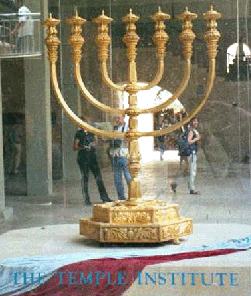
The root of this Tree is embedded in the ancient soil of Western consciousness, and its trunk (its Middle Pillar) runs through the City of David in the center of Europe, not through Palestine.
"It is not surprising that the question of the Menorah's origin should have become an object of research only in more recent times, whereas attempts at interpretation have occurred at practically all periods.
In general it may be said that most scholars now seem to suppose that the Menorah originated from a Sacred Tree, more specifically the Tree of Life of mythology--a primal image which can be glimpsed as early as the third millennium B.C. in the epic of Gilgamesh and the Land of the Living, and which played a decisive role in the Tree cult of the ancient world.
Closely akin to this image and at times identical with it was the presumably older myth of a cosmic tree or World Tree, usually conceived at the center of the earth--sometimes on a Cosmic Mountain of the Gods--with its roots in the Underworld (the realm of the Dead) and its crown in Heaven (realm of the Gods). In short, a sort of imaginary axis mundi or World Pillar whose boughs, as Carlyle said of Yggdrasil, are 'Histories of Nations,' its every leaf 'a biography,' every fiber 'an act or word.'...
In Mesoptamia this was elaborated with the notion that the Divine Tree grew in the mythical Paradise at the source of the Water of Life, where it was guarded and tended for the chief deity by the primordial Man-King. In the ritual, the temple came to represent the deity's 'heavenly dwelling,' the temple grove with the Sacred Tree the legendary Paradise, and the sacral King as the deity's representative its Gardener.
"No less interesting is the parallel between the Temple as an image of the 'heavenly dwelling' and the sanctuary which God on Mount Sinai commands Moses to build. 'And let them make me a sanctuary,' the children of Israel are told, 'that I may dwell in their midst. According to all that I show you concerning the pattern of the tabernacle, and of all its furniture, so shall ye make it,' a reference to heavenly 'patterns' also repeated, as we have seen, in the separate command concerning the menorah. (continued)...
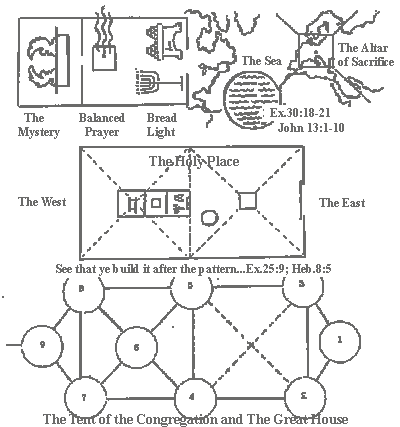
"Last but not least, Aaron's or rather Moses' magical rod--as will appear later likewise a branch of a Sacred Tree--is said by the rabbinic legend to have been 'in the hand of every king of Israel until the temple was destroyed, when it was hidden away...destined to be in the hand of King Messiah.
It may be added that Christian royal sceptres have largely the same derivation, and the cross on the orb (also the earth's astronomical sign) symbolizes nothing other than a Tree of Life growing at the Center of the Earth. This identification of the cross with the Tree of Life or Christ himself--the shoot from the stump of Jesse--becomes especially popular in medieval literature. It presumably also lies behind the Christmas tree of later tradition...Its decoration of candles...is a feature which, as we shall see, it shares with both the Tree of Life and the Menorah." The Sacred Tree, A Study of the Menorah, The Seven-Branched Lampstand, by L. Yarden, pp.35-37.
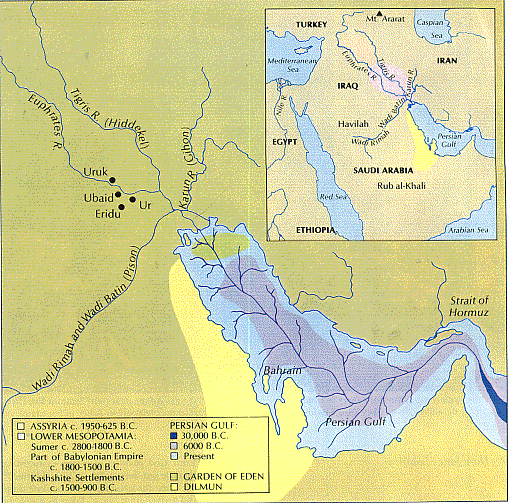
The area thought to be the Garden of Eden,
which was flooded when Gulf waters arose, is shown in green.
Yellow areas of Bahrain and Arabian coast represent Dilmun, paradise land of
Ubaidians and Sumerians
In a study found on www.ldolphin.org/eden/ the author, Dora Jane Hamblin, following the work of Juris Zarins, an eastern archaeologist, asks: "Has the Garden of Eden been located at last?" She writes: "By using an interdisciplinary approach, archaeologist Juris Zarins believes he's found it--and can pinpoint it for us." The author...met Dr. Zarins and his Eden theory when writing of Saudi archaeology (September 1983) and has followed his work since. Professor Zarins bases his theory on Landsat images from space, which have, he says--in order to make the theory hold together--discovered fossil rivers underneath the Arabian sands. His research is stretched (but, of course, so is the Eden-Georgia hypothesis), and relies on too many suppositions and suggestions that there are errors in the received traditions and written texts. Nevertheless, an Arabian-Eden theory goes far in supporting our overall thesis which holds that all things East are a reflection of realities West. The yearly pilgrimage to Mecca itself is an Eastward reflection of the true path history has taken, not only Seven times around the City Above (the Mother of us all...Galatians 4:21-26), but finally to the Western ends of the earth and the fulness of time. Zarin's theory adds theological and historical weight to our own sense of things laid out in the Eighteenth chapter of this work entitled The Mystery of Islam.
God is the Light of the heavens and the earth. His light may be likened to a Lamp within a niche. The Lamp is in a glass and the glass is like a Shining Star.
The Lamp is lit from a Blessed Tree, an Olive neither from the East nor from the West, whose oil would almost shine of itself, even if no Fire touched it.
Light upon light, God guides to His Light those whom He will...(Sura 24.35).
Though the garden of Eden has always been situated here in the West, and though men have for milennia risen up in the East, in all directions searching for it, the most sublime Mystery of all, concealed from both East and West, is the realization of the Great Leviathan and the City of DVD hidden between them:
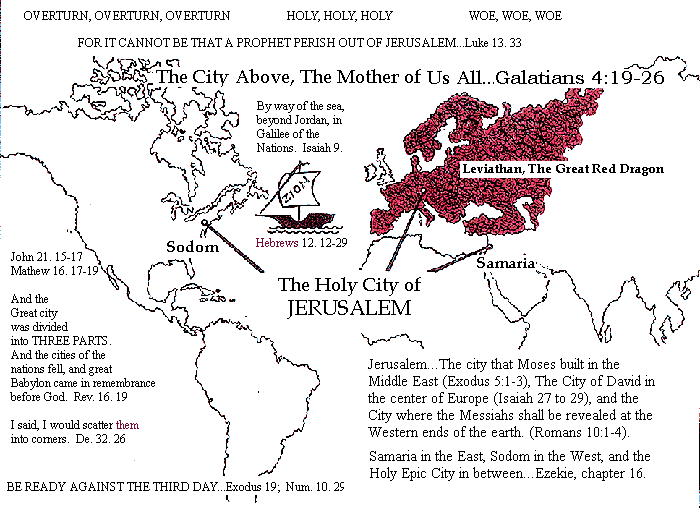
THE QUEST FOR PARADISE
The genesis of this book was a series of lectures in American literature at Middlebury College during the year 1950-1951...(which were summerized) in an essay called The Garden in America...Since then, I have felt the need to penetrate more deeply into the origins and meaning of my subject and, above all, to show its broader application to such other aspects of our civilization as art, industry, politics, and foreign policy...The Edenic myth, it seems to me, has been the most powerful and comprehensive organizing force in American culture...
Because the center of creation was believed to exist at the summit of a sacred mountain where heaven and earth meet, every sacred city of actual history became by extension, as Eliade says, a 'Sacred Mountain.' Thus when American colonists said that they were going to establish in the New World 'A City on a Hill,' they meant to found a sacred city and a new paradise...
Babylon was originally so settled. An ancient map shows it at the center of a vast circular countryside bordered by a river, 'precisely as the Sumerians envisioned Paradise.' Indeed the sacred city takes on the character of the country surrounding it. Hebrew and Christian writers frequently used the terms 'Jerusalem' and 'Paradise' interchangeably. Thus Baruch, in the Syriac Apocalypse, has God complain of worldly Jerusalem. 'This building now built in your midst is not that which is revealed with Me, that which was prepared beforehand here from the time I took counsel to make Paradise, and showed it to Adam before he sinned.' (See Hebrews 13:14; Galatians 4:21-26)...
Since the earthly, temporal city is always corrupt, progress is thought of in terms of an ideal city. But the ideal city lies at the center of creation. Therefore, the idea of progress partakes of a spiritual, sociological, or geographical search for the 'center.' The many journey patterns of antiquity and modern times represent...a search for paradise, which is in part regressive. But the vision of paradise is determined and preceded by a state of intense suffering symbolized by the passage through hell, a night journey, or descent into the sea...
The sad experience in Egypt produced...the passage across the Red Sea, whose waters opened a gateway to the promised land. The Babylonian exile produced the jeremiads of the prophets and their promise of a messiah; it also produced Daniel's descent into the lion's den and his eschatological vision of the Last Days...
The passion play was a product of Roman domination heaped upon a heritage of oppression. The passage of Jesus through the streets of Jerusalem carrying the burdens of the cross to Calvary symbolically re-enacts the suffering of His people. His resurrection, their hope of deliverance...The legalism and exclusiveness of Mosaic teaching was transcended (fulfilled) on a higher plane. In Christ, the earlier geographical searches for the center had become a spiritual quest--and so remained for some thousand years afterward."...
"This happened during the Renaissance when a significant social transformation in Europe coincided with the opening of new lands beyond the seas... The new experience which the seafaring adventurers sought had a great deal to do also with the myth of El Dorado (and the Seventh city of Cibola), believed to exist in the interior of the newly discovered Eden..." The Quest For Paradise, Europe and the American Moral Imagination, by Charles L. Stanford.
The Mysteries of America...The Garden of Eden, (Isaiah 40:21-31); The Feet of Christ, (Isaiah 52:7, Nahum 11:15; Luke 1:76-79; John 13:1-18; Hebrews 12:14-17; Ephesians 6:15; Romans 10:13-16; Hebrews 1:13; Deuteronomy 32: 35); and The Tent of the Congregation, (Hebrews 12:14-29).
__________
The heavens declare the glory of God; and the firmament sheweth His handiwork.
Day unto day uttereth speech, and night unto night sheweth knowledge.
THERE IS NO SPEECH NOR LANGUAGE WHERE THEIR VOICE IS NOT HEARD.
Their line has gone out through all the earth, and their words to the end of the world. IN THEM HATH HE SET A TABERNACLE FOR THE SUN.
Which is as a bridegroom coming out of his chamber, and rejoiceth as a strong man to run a race.
HIS GOING FORTH IS FROM THE END OF THE HEAVEN, AND HIS CIRCUIT UNTO THE ENDS OF IT: and there is nothing hid from the heat thereof...(Psalm 19:1-6).
THE SACRED TREE
Dedicated to the countless clans, tribes and nation of indigenous peoples throughout Mother Earth whose sacred visions, dreams, prayers, songs, wisdom, experience and kind guidance form the Foundation and living reality of the Sacred Tree.
For all the people of the earth, the Creator has planted a Sacred Tree under which they may gather, and there find healing, power, wisdom and security. The roots of this Tree spread deep into the body of Mother Earth. Its branches reach upward like hands praying to Father Sky. The fruits of this Tree are the good things the Creator has given to His people: teachings that show the path to love, compassion, generosity, patience, wisdom, justice, courage, respect, humility and many other gifts.
The ancient ones taught us that the life of the Tree is the life of the people. If the people wander far away from the protective shadow of the Tree, if they forget to seek the nourishment of its fruit, or if they should turn against the Tree and attempt to destroy it, great sorrow will fall upon the people. Many will become sick at heart. The people will lose their power. They will cease to dream dreams and see visions. They will begin to quarrel among themselves over worthless trifles. They will become unable to tell the truth and to deal with each other honestly. They will forget how to survive in their own land. Their lives will become filled with anger and gloom. Little by little they will poison themselves and all they touch.
It was foretold that these things would come to pass, but that the Tree would never die. And as long as the Tree lives, the people live. It was also foretold that the day would come when the people would awaken, as if from a long drugged sleep; that they would begin, timidly at first but then with great urgency, to search again for the Sacred Tree.
The knowledge of its whereabouts, and of the fruits that adorn its branches have always been carefully guarded and preserved within the minds and hearts of our wise elders and leaders. These humble, loving and dedicated souls will guide anyone who is honestly and sincerely seeking along the path leading to the protecting shadow of the Sacred Tree.
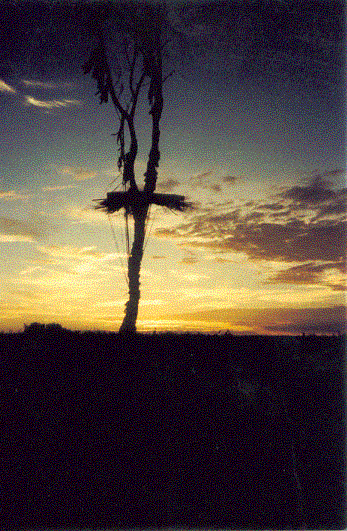
The Symbol of the Sacred Tree
The Sacred Tree as a symbol of life-giving meaning is of vital importance to the indigenous peoples of the earth. For countless generations it has provided meaning and inspiration for many tribes and nations. The Sacred Tree is a symbol around which lives, religions, beliefs and nations have been organized. It is a symbol of profound depth, capable of providing enough meaning for a lifetime of reflection.
The Sacred Tree represents life, cycles of time, the earth, and the universe. The meaning of the Sacred Tree reflects the teachings of the Medicine Wheel. The center of the Medicine Wheel is the symbolic center of creation and of the tribe. This meaning is reflected in a song which is sung on behalf of the Sacred Tree chosen for the Sun Dance.
I am standing
In a sacred way
At the earth's center
Beheld by the people,
Seeing the tribe
Gathered around me.
Symbolically, the Sacred Tree represents a gathering place for the many different tribes and peoples of the world. The Sacred Tree provides a place of protection in the world, a place of peace, contemplation, and centering. Like our mother's womb which provided nourishment and protection during the earliest days of our life, the Sacred Tree may be thought of as a womb of protection which gives birth to our values and potentialities as unique human beings.
The process of developing our uniqueness through the teachings of the Sacred Tree gives rise to a vision, not of what we are, but of what we can become. That vision becomes the path toward our wholeness. Thus we see in the symbolic protection of the Sacred Tree the beginning of our wholeness and the emergance of the seed of our potential."
THE GREAT MYSTERIOUS
"You can call Wakan-Tanka by any name you like. In English I call him God or the Great Spirit. He's the Great Mystery (see 1 Timothy 3:16; 2 Tim. 2:14-21), the Great Mysterious. That's what Wakan-Tanka really means--the Great Mysterious. You can't define Him. He's not actually a 'He' or a 'She," a 'Him' or 'Her.' We have to use those kinds of words because we can't just say 'It.' God's never an 'It.'
So call Wakan-Tanka whatever you like. Just be sure to call him. He wants to talk to you...Noble red Man, Lakota Wisdomkeeper, Matthew King.
Visions, Dreams, and Miracles
"We live by visions. We live by dreams. We live by miracles. Miracles come to us in our everyday lives, in our ceremomies, in our prayers. Every day is a miracle to us.
Many times I have seen the eagle come out of the empty sky and circle over our heads when we blow the eagle-bone whistle. The eagle is the witness of the Great Spirit, the eyes of God...Matthew King.
__________
And it shall come to pass in the last days, saith God, I will pour out my Spirit upon all flesh: and your sons and daughters shall prophesy, and your young men shall see visions, and your old men shall dream dreams.
And on my servants and on my handmaidens I will pour out in those days of my Spirit; and they shall prophesy:
And I will shew wonders in heaven above, and signs in the earth beneath; blood, and fire, and vapour of smoke:
The Sun shall be turned into darkness, and the Moon into blood, before that great and notable day of the Lord come: And it shall come to pass, that whosoever shall call upon the name of the Lord shall be saved....(Acts 2:16-21; Joel 2:28-32).
__________
And to the Woman were given Two Wings of a Great Eagle, that she might fly into the wilderness, into her place, where she is nourished for a time, and times, and a half time from the face of the serpent.
And the serpent (the spirit of Antichrist) cast out of his mouth water as a flood after the Woman, that he might cause her to be carried away of the flood (of the wars that God is bringing upon the earth, against the great serpent).
And the Earth helped the Woman, and the Earth opened up Her mouth, and swallowed up the flood which the dragon cast out of his mouth.
And the dragon (the collective lower nature of the American state of mind) was wroth with the Woman, and went to make war with the remnant of her seed, which keep the commandments of God, and have the testimony of Jesus Christ...(Revelation 12:14-17).
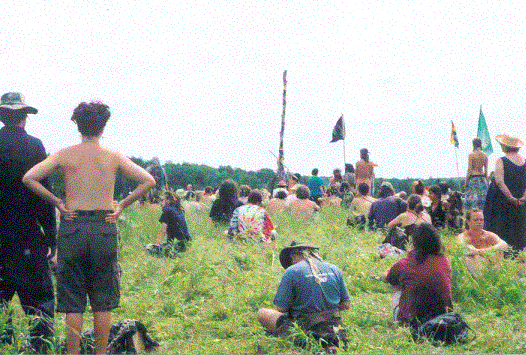
Early morning at the high meadow, waiting for the Sun at noon. There is silence...
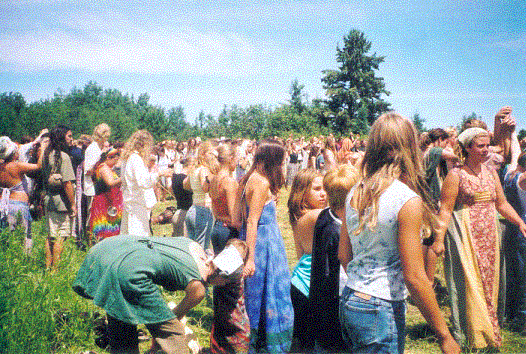
...prayerful meditation, anticipation...and then finally JUBILATION!
Meet at the Center
Create Anew